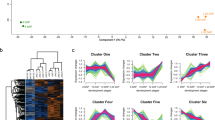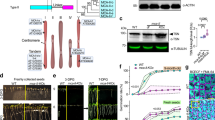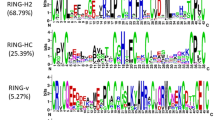Abstract
Rice seeds, a rich reserve of starch and protein, are a major food source in many countries. Unlike the seeds of other plants, which typically accumulate one major type of storage protein, rice seeds use two major classes, prolamines and globulin-like glutelins. Both storage proteins are synthesized on the endoplasmic reticulum (ER) and translocated to the ER lumen, but are then sorted into separate intracellular compartments1,2. Prolamines are retained in the ER lumen as protein bodies whereas glutelins are transported and stored in protein storage vacuoles. Mechanisms responsible for the retention of prolamines within the ER lumen and their assembly into intracisternal inclusion granules are unknown, but the involvement of RNA localization has been suggested3. Here we show that the storage protein RNAs are localized to distinct ER membranes and that prolamine RNAs are targeted to the prolamine protein bodies by a mechanism based on RNA signal(s), a process that also requires a translation initiation codon. Our results indicate that the ER may be composed of subdomains that specialize in the synthesis of proteins directed to different compartments of the plant endomembrane system.
This is a preview of subscription content, access via your institution
Access options
Subscribe to this journal
Receive 51 print issues and online access
$199.00 per year
only $3.90 per issue
Buy this article
- Purchase on SpringerLink
- Instant access to full article PDF
Prices may be subject to local taxes which are calculated during checkout



Similar content being viewed by others
References
Krishnan, H. B., Franceschi, V. R. & Okita, T. W. Immunochemical studies on the role of the Golgi complex in protein body formation in rice seeds. Planta 169 , 471–480 (1986).
Yamagata, H. & Tanaka, K. The site of synthesis and accumulation of rice storage proteins. Plant Cell Physiol. 27, 135–145 (1986).
Okita, T. W. & Rogers, J. C. Compartmentation of proteins in the endomembrane system of plant cells. Annu. Rev. Plant Physiol. & Plant Mol. Biol. 47, 327–350 (1996).
Yamagata, H., Tamura, K., Tanaka, K. & Kasai, Z. Cell-free synthesis of rice prolamin. Plant Cell Physiol. 27, 1419–1422 (1986).
Li, X., Franceschi, V. R. & Okita, T. W. Segregation of storage protein mRNAs on the rough endoplasmic reticulum membranes of rice endosperm cells. Cell 72, 869–879 (1993).
Kim, W. T., Li, X. & Okita, T. W. Expression of storage protein multigene families in developing rice endosperm. Plant Cell Physiol. 34, 595–603 (1993).
Li, X. et al. Rice prolamine protein body biosynthesis: A BiP-mediated process. Science 262, 1054–1056 (1993).
Muench, D. G. et al. Molecular cloning, expression and subcellular localization of a BiP homolog from rice endosperm tissue. Plant Cell Physiol. 38, 404–412 ( 1997).
Muench, D. G., Chuong, S. D. X., Franceschi, V. R. & Okita, T. W. Developing prolamine protein bodies are associated with the cortical cytoskeleton in rice endosperm cells. Planta 211, 227 –238 (2000).
Kim, W. T. & Okita, T. W. Structure, expression, and heterogeneity of the rice seed prolamines. Plant Physiol. 88, 649–655 (1988).
Mitsukawa, N. & Tanaka, K. in Rice Genetics II (ed. Khush, G. S.) 503–512 (International Rice Research Institute, Manila, Philippines, 1991).
Bassell, G. J., Oleynikov, Y. & Singer, R. H. The travels of mRNAs through all cells large and small. FASEB J. 13, 447– 454 (1999).
Jansen, R. P. RNA-cytoskeletal associations. FASEB J. 13, 455–466 (1999).
Dalgleish, G. D., Veyrune, J. L., Accornero, N., Blanchard, J. M. & Hesketh, J. E. Localisation of a reporter transcript by the c-myc 3′-UTR is linked to translation. Nucleic Acids Res. 27, 4363–4368 (1999).
Hiei, Y., Ohta, S., Komari, T. & Kumashiro, T. Efficient transformation of rice (Oryza sativa L.) mediated by Agrobacterium and sequence analysis of the boundaries of the T-DNA. Plant J. 6 , 271–282 (1994).
Acknowledgements
We thank R. S. Boston and F. Takaiwa for providing the maize BiP antibody and prolamine promoter clone. This work was supported in part by United States Department of Agriculture National Research Initiative Competitive Grant Program, by a National Science Foundation Grant, and by Washington State University College of Agriculture and Home Economics Hatch Project.
Author information
Authors and Affiliations
Corresponding author
Rights and permissions
About this article
Cite this article
Choi, SB., Wang, C., Muench, D. et al. Messenger RNA targeting of rice seed storage proteins to specific ER subdomains. Nature 407, 765–767 (2000). https://doi.org/10.1038/35037633
Received:
Accepted:
Issue Date:
DOI: https://doi.org/10.1038/35037633



